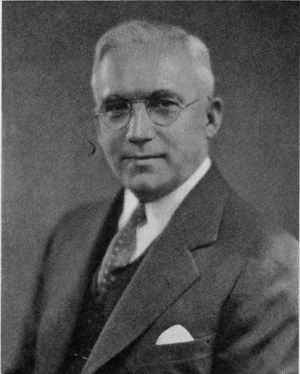William Wickenden: Difference between revisions
No edit summary |
No edit summary |
||
| Line 9: | Line 9: | ||
<p>Wickenden was [[Presidents of the American Institute of Electrical Engineers (AIEE)|AIEE president]] from 1945 to 1946. </p> | <p>Wickenden was [[Presidents of the American Institute of Electrical Engineers (AIEE)|AIEE president]] from 1945 to 1946. </p> | ||
<p>WILLIAM ELGIN WICKENDEN, President, Case School of Applied Science, Cleveland, Ohio, awarded the eighth Lamme medal by the Society for the Promotion of Engineering' Education at its forty-third annual meeting at Georgia School of Technology, Atlanta, Georgia, June 26, 1935. </p> | <p>WILLIAM ELGIN WICKENDEN, President, Case School of Applied Science, Cleveland, Ohio, awarded the eighth [[IEEE Lamme Medal|Lamme medal]] by the Society for the Promotion of Engineering' Education at its forty-third annual meeting at Georgia School of Technology, Atlanta, Georgia, June 26, 1935. </p> | ||
<p>President Wickenden was born in Toledo, Ohio, December 24. 1882. After graduating from Denison University, Ohio, in 1904, he entered upon his teaching career as instructor in physics at Mechanics Institute, Rochester, New York. The following year he became Assistant in Physics at the University of Wisconsin and later transferred to the department of electrical engineering. In 1909 he became Assistant Professor, and in 1914 Associate Professor of Electrical Engineering at Massachusetts Institute of Technology. From 1918 to 1921 he was Personnel Director of the Western Electric Company, was appointed Assistant Vice President of the American Telephone and Telegraph Company in 1921, in 1924 resigned to become Director of the Investigation of Engineering Education for the Society for the Promotion of Engineering Education. He was elected president of Case School of Applied Science in 1929. </p> | <p>President Wickenden was born in Toledo, Ohio, December 24. 1882. After graduating from Denison University, Ohio, in 1904, he entered upon his teaching career as instructor in physics at Mechanics Institute, Rochester, New York. The following year he became Assistant in Physics at the University of Wisconsin and later transferred to the department of electrical engineering. In 1909 he became Assistant Professor, and in 1914 Associate Professor of Electrical Engineering at Massachusetts Institute of Technology. From 1918 to 1921 he was Personnel Director of the Western Electric Company, was appointed Assistant Vice President of the American Telephone and Telegraph Company in 1921, in 1924 resigned to become Director of the Investigation of Engineering Education for the Society for the Promotion of Engineering Education. He was elected president of Case School of Applied Science in 1929. </p> | ||
| Line 23: | Line 23: | ||
<p>See also: [[Archives:Papers of William E. Wickenden|Papers of William E. Wickenden]] </p> | <p>See also: [[Archives:Papers of William E. Wickenden|Papers of William E. Wickenden]] </p> | ||
<p> | <p> </p> | ||
Revision as of 15:25, 25 July 2011
William E. Wickenden: Biography
Born: December 24, 1882
Died: September 1, 1947
Wickenden was AIEE president from 1945 to 1946.
WILLIAM ELGIN WICKENDEN, President, Case School of Applied Science, Cleveland, Ohio, awarded the eighth Lamme medal by the Society for the Promotion of Engineering' Education at its forty-third annual meeting at Georgia School of Technology, Atlanta, Georgia, June 26, 1935.
President Wickenden was born in Toledo, Ohio, December 24. 1882. After graduating from Denison University, Ohio, in 1904, he entered upon his teaching career as instructor in physics at Mechanics Institute, Rochester, New York. The following year he became Assistant in Physics at the University of Wisconsin and later transferred to the department of electrical engineering. In 1909 he became Assistant Professor, and in 1914 Associate Professor of Electrical Engineering at Massachusetts Institute of Technology. From 1918 to 1921 he was Personnel Director of the Western Electric Company, was appointed Assistant Vice President of the American Telephone and Telegraph Company in 1921, in 1924 resigned to become Director of the Investigation of Engineering Education for the Society for the Promotion of Engineering Education. He was elected president of Case School of Applied Science in 1929.
As a teacher, personnel manager, and educational administrator his entire career is characterized by unusual clarity of perception and expression. These qualities have given distinction and exceptional value to the report of the investigation of engineering education, the final volume of which was published last year. The manner in which the investigation was conducted is not only a tribute to his technical ability but shows unmistakably the influence of his administrative genius upon a major survey of educational activities.
He was elected a Member of the Council of the Society in 1924, and in 1933, President. He is the author of a book on Illumination and Photometry. He was Regional Supervisor of Personnel Methods, S. A. T. c., 1918. In recent years he has served as a Director of the Adult Education Association of Cleveland, a Trustee of Cleveland College, President of the Ohio College Association, and consulting member of the Committee on the Improvement of College Teaching of the A. A. U. In civic activities he has served as a Director of the Cleveland Community Fund, Director of the Cleveland Chamber of Commerce, Vice-President of the Cleveland Welfare Federation, Chairman of the Ohio Labor Board and Chairman of the Ohio Highway Survey Committee. He is a member of the Association for the Advancement of Science; American Society of Mechanical Engineers; American Institute of Electrical Engineers; American Association of Political and Social Science; Cleveland Engineering Society; and Cleveland Community Fund.
He is also a member of Sigma Chi, Phi Beta Kappa, and Sigma Xi. Honorary degrees bestowed upon him are: Doctor of Engineering, Lafayette College, 1926, Worcester Polytechnic Institute, 1927, Case School of Applied Science, 1929, and Rose Polytechnic Institute, 1932; Doctor of Science, Denison University, 1928, and Bucknell University, 1930; Doctor of Laws, Oberlin College, 1930; and Doctor of Humane Letters, Otterbein College, 1933.
(Copied from Journal of Electrical Engineering, September, 1935)
See also: Papers of William E. Wickenden
